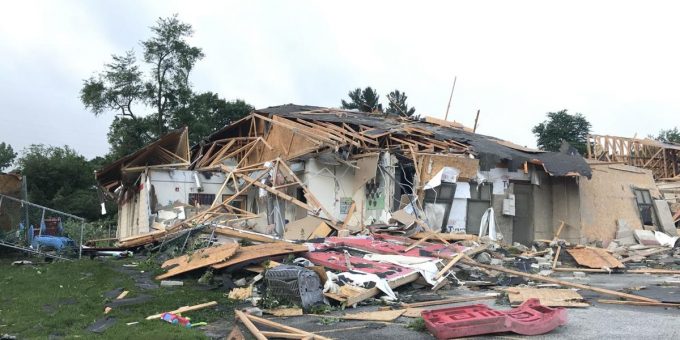
(UNDATED) – Indiana storms in the spring and summer can produce potentially damaging weather. Knowing what to do before and after a storm can help protect your family and your property.

“Far too often residents of Indiana are not aware if they have adequate coverage from their insurance policies, especially when it comes to damage as a result of storms that produce heavy rains and cause flooding. The Department urges Hoosiers to review their insurance policies, including rental insurance to make sure they understand their coverage before a disaster hits,” said Indiana Department of Insurance Commissioner Stephen W. Robertson.
The Indiana Department of Insurance offers tips on disaster preparedness, including what to do before and after a storm hits, and how to protect yourself from fraud.
Understanding Extreme Weather Hazards
Check the weather online or a broadcast outlet every morning to better understand what the day may bring. Unpredictable weather means storms can come on quickly, taking you by surprise. Consider the following:
- Tornadoes can hit anywhere, anytime. Of the 50 states, 49 have experienced a tornado since 2005. Make sure to identify a shelter and practice an annual family tornado drill.
- Lightning is common, even if getting struck is rare. Stay inside during a lightning storm and take precautions such as unplugging your appliances and avoid talking on a phone.
- Flash floods are the cause of the most deaths associated with severe weather. Just one inch of water can cause $20,000 in damage to your home. If you live in a 100-year floodplain, there’s more than a 25 percent chance that you’ll be flooded during a 30-year mortgage. In that period, you are 27 times more likely to experience a flood than have a fire. It takes just 12 inches of rushing water to carry away a car. Don’t ever drive or walk into floodwaters and never underestimate the power of flowing water.
Create a Home Inventory
To make the claims process easier, create a home inventory of your belongings. Include identifying information about your possessions (brand name, price, purchase date, model, serial number and receipts) and take photos. The National Association of Insurance Commissioners (NAIC) has created a free smartphone app that will help you create a database of your possessions. The app is available for iPhone and Android. A simple-to-use printable home inventory checklist is also available.
If you don’t have time to create a full list of the items in your home, consider videotaping and/or taking photographs in every room. The more detail you include, the easier it will be for your insurer to evaluate your loss. When making your list, open drawers and closets, and don’t forget to document what’s in your basement, garage and storage buildings.
Once you’ve created your inventory, send the information to your insurance agent and/or keep it on your app.
Collect Your Insurance Information
Before a storm hits, review your insurance policies. Make sure you know what is and is not covered. If you have questions, contact your insurance agent or insurer.
Store electronic copies of your insurance policies with your home inventory and keep paper files in a safety deposit box. Make sure to have a copy of your policy declarations page listing all of your coverages, as well as your insurance cards.
Collect the 24-hour contact information for your insurance agent and insurer and enter it as a contact on your smartphone. Make a list that includes your policy numbers, insurer and insurance agent’s phone numbers, website addresses and mailing addresses. Also, check to see if the company or agent has an emergency information hotline. It is a good idea to store this information — and your home inventory — in a waterproof, fireproof box or safe. If you evacuate your home, take this information with you.
Note: Flood damage is generally not covered by a standard homeowners or renter’s insurance policy. If you have a separate flood insurance policy, remember to include a copy of the policy and the contact details for the insurer on your list. A flood is a covered event in most auto insurance policies. If you need flood insurance, you’ll want to purchase it now because typically there is a 30-day waiting period from the date of purchase before the policy goes into effect.
For more information about flood insurance, check out this consumer alert issued by the Indiana Department of Insurance.
Prepare for the Worst
To help lessen the damage caused by a storm, take stock of your home. Clear your yard of debris that could become projectiles in high winds and trim dead or overhanging branches from trees surrounding your home. Ensure the roof sheathing is properly secured. Fasten end gables to the roof. Latch doors and garage doors properly. Secure shutters and outdoor furniture.
For personal safety, identify the nearest storm shelter and have an emergency or evacuation plan for your family. Practice your evacuation plan, making sure everyone knows where emergency supplies are stored. Have a storm survival kit that includes bottled water, a first-aid kit, flashlights, a battery-operated radio, at least three days of nonperishable food items, blankets, clothing, prescription drugs, eyeglasses and personal hygiene supplies.
If you must evacuate your home, turn off all utilities and disconnect appliances, reducing the chance of additional damage and electrical shock when utilities are restored.
For more information about how to prepare your family and home for weather threats, visit the American Red Cross.
After the Storm
The days following a natural disaster can be confusing and stressful, but report your insurance claim(s) as quickly as possible to help protect your financial future.
Contact your insurer and/or agent with your policy number and other relevant information. Be aware that your policy might require that you make this notification within a certain time frame.
Document damage by taking photographs/video before you begin any clean-up. After you’ve documented the damage, make repairs necessary to prevent further harm to your property (cover broken windows, leaking roofs and damaged walls). Don’t make permanent repairs until your insurer has inspected the property and you have reached an agreement on the cost. Be prepared to provide the claims adjuster with records of any improvements you made prior to the damage. Save all receipts, including those from temporary fixes.
If your home is damaged to the extent that you cannot live there, ask your insurer or insurance agent if you have coverage for additional living expenses.
Work with your insurer to learn what documents, forms and data you need for your claim. Keep a diary of all conversations you have with the insurer and your insurance agent, including names, times and dates of the calls or visits, and contact details. Provide your insurer with all of the requested information, as incorrect or incomplete information may delay your claim.
If the first offer made by the insurer does not meet your expectations, be prepared to negotiate. If there is a disagreement about the claim, ask the insurer for the specific language in the policy, and determine why you and the insurer interpret your policy differently. If you believe you are being treated unfairly, contact the Indiana Department of Insurance.
Protect Yourself from Fraud
Home repair fraud is common after a major weather event. Get more than one bid from contractors and request at least three references. Ask for proof of necessary licenses, building permits, insurance, and bonding. Record the contractor’s license plate number and driver’s license number, and then check for any complaints with the Better Business Bureau. Finally, be wary of contractors who demand up-front payment for repairs. Ask for references and verify contractors are legitimate.



